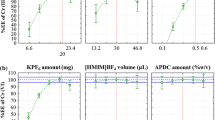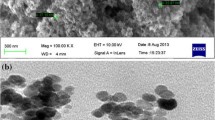Abstract
This study describes the development by response surface methodology (RSM) of a procedure for copper determination by inductively coupled plasma optical emission spectrometry (ICP-OES) in water and biological samples after extraction by magnetic nanoparticles. Four variables such as, pH of solution, amount of extractant, amount of nanoparticles, and time were regarded as factors in the optimization study. Results of the two-level full factorial design (24) based on an analysis of variance demonstrated that only the pH, amount of extractant (E), and amount of nanoparticles (N) were statistically significant. Optimal conditions for the extraction of copper samples were obtained by using Box–Behnken design. Optimum conditions were 5.1, 7.2 mg, and 9.6 mg, for pH of solution, amount of nanoparticles, and amount of extractant, respectively. Under the optimized experimental conditions, the detection limit of the proposed method followed by ICP-OES was found to be 0.9 µg L−1. The method was applied to the determination of copper in water and biological samples.

Similar content being viewed by others
References
Shams E, Babaei A, Soltaninezhad M (2004) Simultaneous determination of copper, zinc and lead by adsorptive stripping voltammetry in the presence of Morin. Anal Chim Acta 501:119–124
WHO (1982) Technical report series, evaluation of certain food additives and contaminants. WHO, Geneva No. 683
Zni Y, Chang X, Zhu X, Luo H, Hu Z, Zou X, He Q (2007) Chemically modified silica gel with p-dimethylaminobenzaldehyde for selective solid-phase extraction and preconcentration of Cr(III), Cu(II), Ni(II), Pb(II) and Zn(II) by ICP-OES. Microchem J 87:20–26
Kaminski MD, Nunez L, Visser AE (1999) Evaluation of extractant—coated ferromagnetic microparticles for the recovery of hazardous metals from waste solution. Sep Sci Technol 34:1103–1120
Montgomery DC (1997) Design and analysis of experiments, 4th edn. Wiley, New York
Box GEP, Hunter WG, Hunter JS (1997) Statistics for experimenters. Wiley, New York
Ferreira HS, Santos ACN, Portugal LA, Costa ACS (2008) Pre-concentration procedure for determination of copper and zinc in food samples by sequential multi-element flame atomic absorption spectrometry. Talanta 77:73–76
Nazari F, Ebrahimi SN, Talebi M, Rassouli A, Bijanzadeh HR (2007) Multivariate optimisation of microwave assisted extraction of capsaicin from capsicum frutescens L. and quantitative analysis by 1H-NMR. Phytochem Anal 18:333–340
Buco S, Morgagues M, Sergent M, Doumenq P, Mille G (2007) An experimental design approach for optimizing polycyclic aromatic hydrocarbon analysis in contaminated soil by pyrolyser-gas chromatography-mass spectrometry. Environ Res 104:209–215
Sivakumar M, Annadurai G, Mohan D (1999) Studies on Box-Behnken design experiments: cellulose acetate-polyurethane ultrafiltration membranes. Bioprocess Eng 21:65–68
Santelli RE, Bezerra MA, SantAna OD, Cassella RJ, Ferreira SLC (2006) Multivariate technique for optimization of digestion procedure by focussed microwave system for determination of Mn, Zn and Fe in food samples using FAAS. Talanta 68:1083–1088
Santos WLD, Santos CMMD, Costa JLO, Andrade HMC, Ferreira SLC (2004) Multivariate optimization and validation studies in on-line pre-concentration system for lead determination in drinking water and saline waste from oil refinery. Microchem J 77:123–129
Shokuhfar A, Khalili SMR, Ashenai Ghasemi F, Malekzadeh K, Raissi S (2008) Analysis and optimization of smart hybrid composite plates subjected to low-velocity impact using the response surface methodology (RSM). Thin-walled Struct 46:1204–1212
Author information
Authors and Affiliations
Corresponding author
Rights and permissions
About this article
Cite this article
Khajeh, M. Application of Factorial Design and Box–Behnken Matrix in the Optimization of a Magnetic Nanoparticles Procedure for Copper Determination in Water and Biological Samples. Biol Trace Elem Res 135, 355–363 (2010). https://doi.org/10.1007/s12011-009-8509-4
Received:
Accepted:
Published:
Issue Date:
DOI: https://doi.org/10.1007/s12011-009-8509-4




